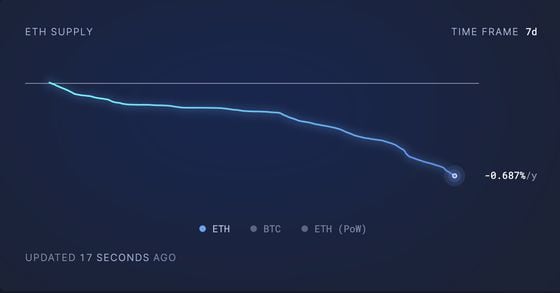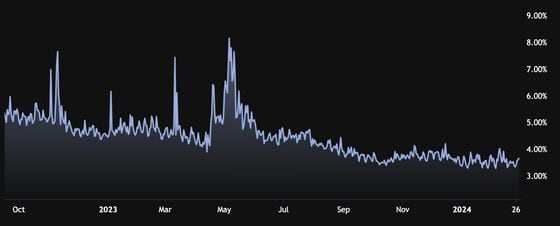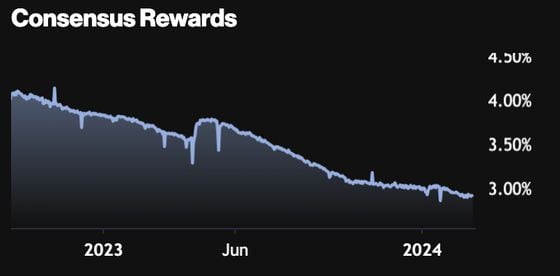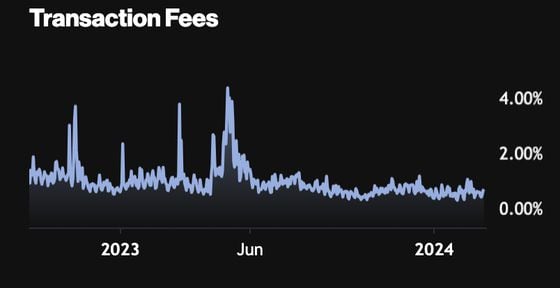
The Ethereum network generates over $1 million daily in transaction revenue, up 35% from one year ago. Participants can stake their asset to be a validator and earn revenue or yield. ETH's all-time high was $4,729 and is currently close to $1,000 away.
Christopher Perkins from CoinFund explains how ether and staking are part of an emerging on-chain financial product.
Alex Ryvkin from Rho Labs covers common questions on the topic in Ask an Expert.
In this article, we reference Ethereum, ether and ETH - for clarity, Ethereum refers to the blockchain network while ether and ETH refer to the cryptocurrency.
Happy reading.
– S.M.
You’re reading Crypto for Advisors, CoinDesk’s weekly newsletter that unpacks digital assets for financial advisors. Subscribe here to get it every Thursday.
With over $10 billion in inflows in less than two months, the spot bitcoin ETF is already considered the most successful product launch in ETF history, drawing widespread mainstream attention to the exciting crypto asset class. With its supply cap of 21 million tokens, bitcoin’s narrative as “digital gold” or a store of value is easily understood. Now, investors are asking, “What’s next?”
Enter ether, the second largest crypto asset by market capitalization. Ethereum pioneered “smart contracts” that now include decentralized finance (DeFi), non-fungible tokens (NFTs) and other applications across the ecosystem. These applications have skyrocketed since Ethereum was conceived nearly 10 years ago, driving demand for its native token, ether (ETH) which is needed to pay for “gas” to record transactions on its blockchain. Like Bitcoin, Ethereum has taken steps to stabilize its monetary supply, and today, its token supply is slightly deflationary:
Figure 1: Supply of ether (Source: Ultrasound.money)

Any asset with a stable supply, increasing demand and obvious utility could be worthy of investment research. Ethereum also delivers a compelling yield to those who participate in its security as network validators via a process called “staking.”
Unlike Bitcoin, which relies upon miners to solve mathematical equations known as “proof of work” to validate transactions, Ethereum migrated to a “proof of stake” validation mechanism in 2022. Under this approach, those who participate in securing the network by “staking” their tokens are rewarded by the protocol, and the validators also receive awards known as priority transaction fees, as an extra incentiveto include a user’s transaction in the upcoming block.
Today, there are nearly 1 million validators on the Ethereum network, and the combination of protocol rewards and priority transaction fees, against the backdrop of a stable monetary supply, result in a compelling [real] yield for investors.
Figure 2: The Composite Ether Staking Rate, CESR (Source: CoinDesk Indices)

So, while bitcoin has become known as “digital gold,” Ether's narrative has shifted to “the internet bond” because of this underlying staking yield. To fully understand the investment case, it’s important to understand the drivers of its yield: 1) protocol or consensus layer awards and 2) priority transaction fees or execution layer rewards.
Consensus awards are given to validators by the protocol for securing it. The size of the rewards are correlated to the number of validators that are securing the network. Since these rewards are shared across the validators, the more validators, the lower the rewards. Ethereum has seen the number of validators increase materially since it transitioned to proof of stake. As a result, consensus rewards have declined over that time period.
Figure 3: Ethereum consensus layer rewards (Source: CoinDesk Indices)

Priority transaction fees are the second component of Ethereum’s native yield and these rewards are generated through transaction processing, paid by users. The volatility of these execution rewards is correlated to the level of activity and demand across the ecosystem. Notably, transaction fees spiked during the insolvencies of FTX (November 2022) and Silicon Valley Bank (March 2023) and during a frenzy of memecoin trading activity (May 2023), since users raced to confirm their transactions on the blockchain.
Figure 4: Ethereum Transaction Fees (Source: CoinDesk Indices)

Today, Ethereum’s staking yield powers the new “internet bond.” Like traditional rates, staked ether’s real yield can power competitive returns, unlock structured products and enable new classes of derivatives. As investor attention pivots to ether, “total return” products that integrate its native yield will certainly take center stage.
- Christopher Perkins, managing partner and president, CoinFund
Q. Despite spot bitcoin ETF approvals and the impending halving, ether is still outperforming bitcoin YTD. What could be the reasons for that?
A: In recent days, bitcoin has stolen the limelight from ether, as its price jumped to a new all-time high on Tuesday. However, ETH remains the better-performing asset, with an exceptional YTD return of 68.13%.
While Bitcoin boasts perhaps the strongest and most dedicated community in crypto, Ethereum has become the infrastructure layer for the vast majority of blockchain applications. As network adoption grows, Ethereum is offering holders of ETH the opportunity to participate in network fees via native staking. Ether’s wide adoption, deflationary nature and native yield constitute a large part of the asset’s appeal.
As a function of network usage, ETH’s native yield tends to fluctuate quite heavily depending on the state of the crypto market. To further the attractiveness of ETH as an asset, especially with institutional and non-crypto-native audiences, products enabling fixed-yield ETH staking may be required.
Q. What does the future of ETH staking look like?
A: In traditional finance, yield is king. With institutional interest towards ETH on the rise, and the growing popularity of staking-focused DeFi protocols such as Lido and EigenLayer (the latter flipped Aave this week to become the second-largest DeFi protocol behind Lido), the importance of native ETH yield will also continue to grow.
Most recently, asset managers such as ETC Group and CoinShares started offering total-return ETPs that add a staking yield kicker on top of ETH token performance. In the US, Franklin Templeton and Grayscale also look to incorporate staking into their proposed ETFs.
In the non-ETH realm, Grayscale has recently announced its actively managed Dynamic Income staking fund, further proving the importance of income-focused products for the ecosystem. It is safe to say that as the investors’ familiarity with the asset class grows, staking yields will become table stakes for serious ETH-based products and services.
The US spot bitcoin ETFs surpassed $50 million AUM this week, less than two months after their launch.
The Securities and Exchange Commission has again delayed its decision on BlackRock and Fidelity’s spot ETH applications.
Bank of America’s Merrill and Wells Fargo provide clients access to the spot bitcoin ETFs.
免责声明:本文章仅代表作者个人观点,不代表本平台的立场和观点。本文章仅供信息分享,不构成对任何人的任何投资建议。用户与作者之间的任何争议,与本平台无关。如网页中刊载的文章或图片涉及侵权,请提供相关的权利证明和身份证明发送邮件到support@aicoin.com,本平台相关工作人员将会进行核查。










暂时没有评论,赶紧抢沙发吧!